Advertisements
Advertisements
प्रश्न
Figure shows two parallel wires separated by a distance of 4.0 cm and carrying equal currents of 10 A along opposite directions. Find the magnitude of the magnetic field B at the points A1, A2, A3.

उत्तर
For point A1,
Magnitude of current in wires, I = 10 A
Separation of point A1 from the wire on the left side, d = 2 cm
Separation of point A1 from the wire on the right side, d' = 6 cm
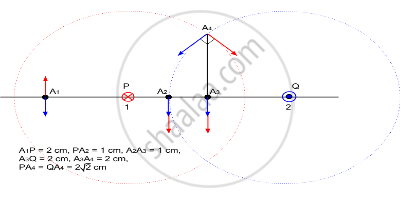
In the figure
Red and blue arrow denotes the direction of magnetic field due to the wire marked as red and blue respectively.
P (marked red) denotes the wire carrying current in a plane going into the paper.
Q (marked blue) denotes the wire carrying current in a plane coming out of the paper.
Also from the figure, we can see that
\[P A_4 = Q A_4 \]
\[\angle A_4 A_3 P = \angle A_4 A_3 Q = 90^\circ \]
\[ \Rightarrow \angle A_4 P A_3 = \angle A_4 Q A_3 = 45^\circ \]
\[ \Rightarrow \angle P A_4 A_3 = \angle Q A_4 A_3 = 45^\circ \]
\[ \Rightarrow \angle P A_4 Q = 90^\circ \]
The magnetic field at A1 due to current in the wires is given by
\[B = \frac{\mu_0 I}{2\pi d} - \frac{\mu_0 I}{2\pi d'}\] ...(1)
\[\Rightarrow B = \frac{2 \times {10}^{- 7} \times 10}{2 \times {10}^{- 2}} - \frac{2 \times {10}^{- 7} \times 10}{6 \times {10}^{- 2}}\]
\[ = \left( 1 - \frac{1}{3} \right) \times {10}^{- 4} \]
\[ = 0 . 67 \times {10}^{- 4} T\]
Similarly, we get the magnetic field at A2 using eq. (1).
\[B = \frac{2 \times {10}^{- 7} \times 10}{1 \times {10}^{- 2}} + \frac{2 \times {10}^{- 7} \times 10}{3 \times {10}^{- 2}}\]
\[ = \frac{8}{3} \times {10}^{- 4} T\]
\[ = 2 . 67 \times {10}^{- 4} T\]
Now,
Magnetic field at A3:
\[B = \frac{2 \times {10}^{- 7} \times 10}{2 \times {10}^{- 2}} + \frac{2 \times {10}^{- 7} \times 10}{2 \times {10}^{- 2}}\]
\[ = 2 \times {10}^{- 4} T\]
Separation of point A4 from the wire on the left side, d = \[\sqrt{2^2 + 2^2} = 2\sqrt{2} \] cm
\[B = \sqrt{\left( \frac{2 \times {10}^{- 7} \times 10}{2\sqrt{2} \times {10}^{- 2}} \right)^2 + \left( \frac{2 \times {10}^{- 7} \times 10}{2\sqrt{2} \times {10}^{- 2}} \right)^2}\]
\[ = 1 \times {10}^{- 4} T\]
APPEARS IN
संबंधित प्रश्न
Two infinitely long straight parallel wires, '1' and '2', carrying steady currents I1 and I2 in the same direction are separated by a distance d. Obtain the expression for the magnetic field `vecB`due to the wire '1' acting on wire '2'. Hence find out, with the help of a suitable diagram, the magnitude and direction of this force per unit length on wire '2' due to wire '1'. How does the nature of this force changes if the currents are in opposite direction? Use this expression to define the S.I. unit of current.
Two infinitely large plane thin parallel sheets having surface charge densities σ1 and σ2 (σ1 > σ2) are shown in the figure. Write the magnitudes and directions of the net fields in the regions marked II and III.
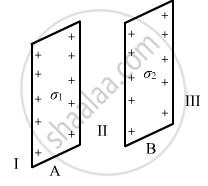
An electron is moving along the positive x-axis. You want to apply a magnetic field for a short time so that the electron may reverse its direction and move parallel to the negative x-axis. This can be done by applying the magnetic field along
(a) y-axis
(b) z-axis
(c) y-axis only
(d) z-axis only
A long, straight wire of radius R carries a current distributed uniformly over its cross section. T he magnitude of the magnetic field is
(a) maximum at the axis of the wire
(b) minimum at the axis of the wire
(c) maximum at the surface of the wire
(d) minimum at the surface of the wire.
A copper wire of diameter 1.6 mm carries a current of 20 A. Find the maximum magnitude of the magnetic field `vecB` due to this current.
A transmission wire carries a current of 100 A. What would be the magnetic field B at a point on the road if the wire is 8 m above the road?
The magnetic field existing in a region is given by `vecB = B_0(1 + x/1)veck` . A square loop of edge l and carrying a current i, is placed with its edges parallel to the x−y axes. Find the magnitude of the net magnetic force experienced by the loop.
Figure shows a metallic wire of resistance 0.20 Ω sliding on a horizontal, U-shaped metallic rail. The separation between the parallel arms is 20 cm. An electric current of 2.0 µA passes through the wire when it is slid at a rate of 20 cm s−1. If the horizontal component of the earth's magnetic field is 3.0 × 10−5 T, calculate the dip at the place.
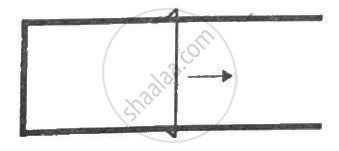
Four long, straight wires, each carrying a current of 5.0 A, are placed in a plane as shown in figure. The points of intersection form a square of side 5.0 cm.
(a) Find the magnetic field at the centre P of the square.
(b) Q1, Q2, Q3, and Q4, are points situated on the diagonals of the square and at a distance from P that is equal to the diagonal of the square. Find the magnetic fields at these points.
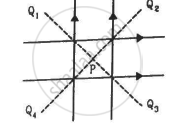
Consider a 10-cm long piece of a wire which carries a current of 10 A. Find the magnitude of the magnetic field due to the piece at a point which makes an equilateral triangle with the ends of the piece.
A straight, how wire carries a current of 20 A. Another wire carrying equal current is placed parallel to it. If the force acting on a length of 10 cm of the second wire is 2.0 × 10−5 N, what is the separation between them?
Two parallel wires separated by a distance of 10 cm carry currents of 10 A and 40 A along the same direction. Where should a third current by placed so that it experiences no magnetic force?
A milli voltmeter of 25 milli volt range is to be converted into an ammeter of 25 ampere range. The value (in ohm) of necessary shunt will be ______.
Do magnetic forces obey Newton’s third law. Verify for two current elements dl1 = dlî located at the origin and dl2 = dlĵ located at (0, R, 0). Both carry current I.
The figure below are two long, parallel wires carrying current in the same direction such that I1 < I2.
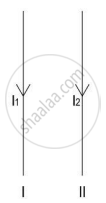
- In which direction will wire I1 move?
- If the direction of the current I2 is reversed, in which direction will the wire I1 move now?
